Commercial On-Grid Solar Solutions
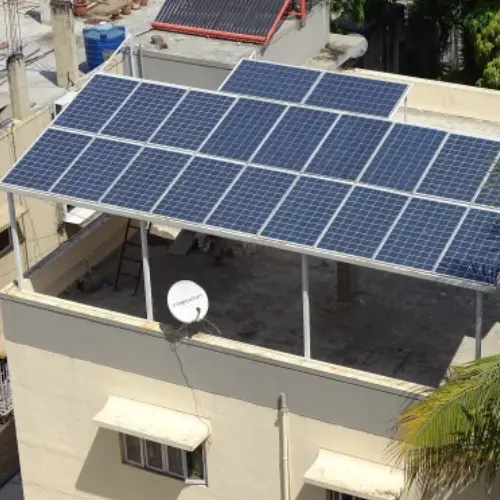
Commercial establishments, including offices, hospitals, malls, hotels, IT parks, and educational institutions, face increasing electricity costs due to continuous operations. Commercial on-grid solar systems provide a sustainable and cost-effective way to meet these energy needs. By generating power from sunlight while staying connected to the utility grid, businesses can reduce energy bills, enhance sustainability, and ensure uninterrupted operations.
These solar grid tied systems for commercial buildings operate in real-time, automatically utilizing solar power during daylight hours and drawing electricity from the grid during periods of low solar production.
Synergy Solar, is a trusted commercial solar installer and supplier in Tamil Nadu, Chennai, Coimbatore, Bangalore, Pune, Maharashtra, Gujarat, Karnataka, and across India, we provide end-to-end on-grid solar solutions for businesses. Our expertise includes system design, supply of Tier-1 solar panels and inverters, professional installation, and long-term maintenance. With our grid-tied solar panels for commercial buildings, businesses can generate clean power during the day and seamlessly draw from the utility grid when needed, ensuring both cost savings and reliability.
Key Benefits of Commercial On-Grid Solar Systems for Businesses
- Significant reduction in monthly electricity expenses
- Reliable and uninterrupted power supply
- Compliance with environmental and sustainability regulations
- Long-term financial savings and ROI
How Commercial On-Grid Solar Systems Work
A grid-tied solar solution for commercial use integrates solar panels, inverters, and the utility grid to optimize power consumption and reduce dependency on grid electricity.
Solar PV Panels: Capture sunlight and convert it into direct current (DC) electricity.
Inverter: Converts DC electricity into alternating current (AC) to power your building’s electrical systems.
Grid Export: Excess energy generated by the solar panels is sent back to the grid, earning you revenue/credits through Gross Metering or Net Feed-in (depending on state regulations).
Bi-Directional Meter: Measures the energy produced by your solar system and tracks how much electricity you send to and pull from the grid.
Grid Backup: Automatically pulls electricity from the grid when solar energy is insufficient, ensuring uninterrupted power supply.
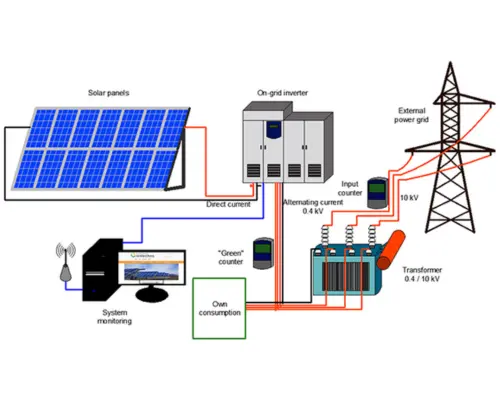
Benefits of On-Grid Solar Energy for Commercial Use
Reduced Energy Bills
- Can reduce electricity costs by 40–60%, depending on consumption patterns and system size.
- Net metering allows surplus energy to generate credits or additional revenue.
Minimal Maintenance
- Panels require only periodic cleaning; inverters may need checks every few years.
- Reduces long-term operational costs compared to diesel generators.
Scalability
- Systems can be expanded to accommodate growing energy requirements.
- Modular design allows businesses to upgrade capacity easily.
Environmental Sustainability
- Reduces carbon emissions and reliance on fossil fuels.
- Supports ESG compliance, green building certifications, and CSR initiatives.
Reliable Power Supply
- Continuous supply during daylight with grid backup ensures zero downtime.
- Critical for hospitals, IT facilities, and data centers.
Key Components of Commercial On-Grid Solar Systems in India
A commercial on-grid solar installation is made up of several essential components that ensure seamless power generation, grid integration, and long-term performance. As one of the leading commercial solar installers and suppliers in India, we provide Tier-1 equipment and professional EPC services to businesses nationwide.
High-Efficiency Solar Panels
- Panels convert sunlight into electricity with high efficiency, typically 17–22%, ensuring maximum output.
- Designed to perform reliably in diverse Indian climates—whether it’s high heat, heavy monsoons, or dusty industrial zones.
- Panels supplied for commercial solar systems in India have a lifespan of 25–30 years, offering long-term stability and ROI.
Industrial-Grade Solar Inverters
- Inverters convert DC power from solar panels into AC electricity suitable for commercial operations.
- Our on-grid solar inverters for commercial buildings in India feature advanced load management, grid synchronization, and power quality stabilization.
- Built with protective systems like anti-islanding and surge resistance for enhanced safety and reliability.
Grid Connection & Net Metering Systems
- Directly connects the solar system to the national/state electricity grid, ensuring power availability at all times.
- Through net metering policies available across India, businesses can export surplus solar energy back to the grid and earn energy credits, further reducing operational costs.
- Includes synchronization and safety devices to protect both the grid and the commercial building.
Monitoring & Control Platforms
- Cloud-based dashboards and SCADA systems track electricity generation, consumption, and financial savings in real time.
- AI-driven analytics help identify underperformance, enabling predictive maintenance and improved efficiency.
- These systems are especially valuable for multi-site businesses operating across different regions of India.
Mounting Structures & Safety Equipment
- Panels are installed using robust aluminum or galvanized steel mounting structures, designed to withstand India’s varied conditions—cyclones, high wind loads, and extreme heat.
- Safety components such as lightning arrestors, isolators, and surge protectors ensure smooth and secure operation.
- Engineered to maximize solar exposure and optimize long-term durability for commercial rooftops and ground-mounted systems.
Applications of On-Grid Solar Solution for Commercial Use
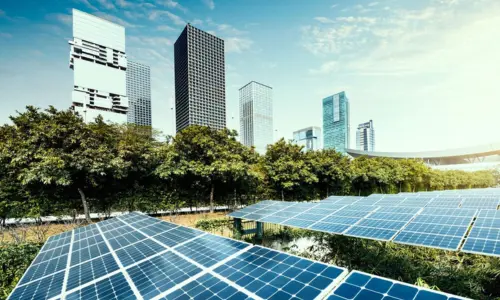
Office Complexes & IT Parks
Reduces grid dependency during peak operational hours; supports lighting, HVAC, and IT infrastructure.
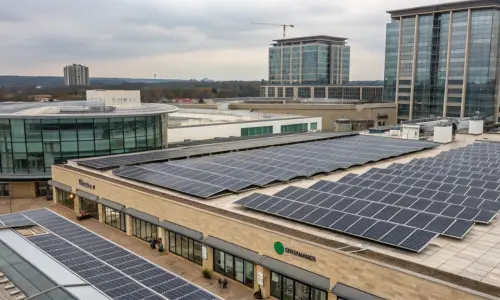
Shopping Malls & Retail Chains
Powers lighting, escalators, air conditioning, and security systems sustainably.
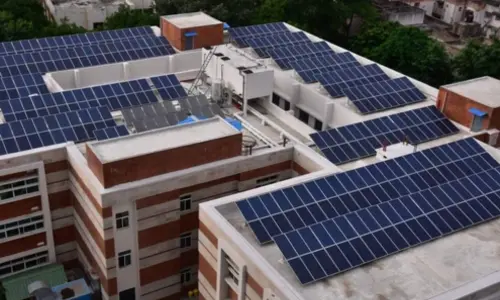
Hotels & Hospitals
Ensures continuous operations and reduces dependency on diesel generators.
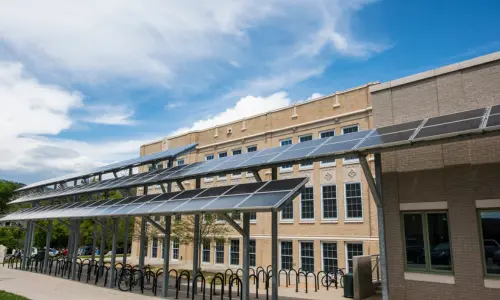
Educational Institutions
Powers campuses while promoting sustainability and reducing electricity bills.

Industrial Parks & Multi-Building Complexes
Centralized solar installations can offset cumulative energy consumption.
Challenges of Commercial On-Grid Solar Solutions
Grid Dependency
- Pure on-grid systems cannot operate during outages.
- Hybrid or battery-integrated systems can provide uninterrupted power.
Initial Investment
High upfront costs may deter adoption, but subsidies, loans, and accelerated depreciation make it financially viable.
Space Requirements
- Large rooftop or open land areas are required for higher-capacity systems.
- Innovative solutions include dual-use rooftops or vertical panel installations.
Government Subsidies & Financial Benefits for Commercial On-Grid Solar
- Grid-Connected Rooftop Solar Programme (MNRE, Central Govt.)
• 40% subsidy for systems up to 3 kW, 20% for 3–10 kW commercial systems.
• Net metering and accelerated depreciation reduce overall project cost. - Production Linked Incentive (PLI) Scheme for High-Efficiency Solar PV Modules
• Encourages the use of domestically manufactured high-efficiency modules. - State-Level Policies (Tamil Nadu, Maharashtra, Gujarat, Karnataka)
• Offers net metering, energy banking, and partial capital subsidies for commercial solar projects.
Why Choose Us for Commercial On-Grid Solar Solutions
With successful projects across Tamil Nadu, Karnataka, Maharashtra, and Gujarat, we are recognized as one of the best commercial solar EPC companies in India. From Chennai offices to Coimbatore hospitals and Bangalore IT parks, our on-grid solar installations are tailored for maximum savings and sustainability.
Proven Expertise
Proven track record in commercial solar installations.
Financial Guidance
Assistance with subsidies, AD, and ROI planning.
Premium Technology
Tier-1 solar panels and industrial-grade inverters.
Sustainability Commitment
Helping businesses achieve green energy goals and ESG compliance.
Custom Engineering
Tailored systems based on load profile and operational needs.
End-to-End Support
Consultation, design, installation, and maintenance.
Frequently Asked Questions
What is the ROI for commercial on-grid solar systems?
Typically 3–5 years, depending on consumption and local electricity tariffs.
Can my building operate solely on solar?
Solar powers daytime operations; hybrid systems are required for 24/7 power.
Are net metering policies applicable for commercial establishments?
Yes, most Indian states allow commercial rooftop solar grid tie with net metering or energy banking.
How much rooftop space is needed for a 500 kW system?
Around 50,000–70,000 sq. ft., depending on panel efficiency and layout.
What is the lifespan of commercial solar panels and inverters?
Panels last 25–30 years, inverters 10–12 years, with minimal maintenance required.
